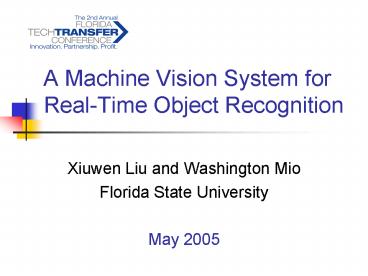A Machine Vision System for RealTime Object Recognition - PowerPoint PPT Presentation
1 / 27
Title:
A Machine Vision System for RealTime Object Recognition
Description:
An automated, real-time machine vision system that can be trained to detect and ... frontal face detection, not recognition, has been developed by Viola and Jones. ... – PowerPoint PPT presentation
Number of Views:90
Avg rating:3.0/5.0
Title: A Machine Vision System for RealTime Object Recognition
1
A Machine Vision System for Real-Time Object
Recognition
- Xiuwen Liu and Washington Mio
- Florida State University
- May 2005
2
The Technology
- An automated, real-time machine vision system
that can be trained to detect and recognize
objects in images and videos. - Key Elements
- New machine learning strategies
- Features used for object recognition
- Real-time execution
3
Example Face Recognition
- Recognize individuals from facial images.
- Subjects say, 10,000 specific individuals.
- Imaging device a video camera.
- Environment an airport or an office building.
4
Face Recognition
5
Training
- This is the most complex part of the entire
system, yet simple from the users standpoint.
Only training data for a specific task needs to
be provided by the user. - For a dynamic collection of targets, small system
updates can be made by a non-technical user.
6
Training Data Subjects
- A few images of the subjects for the system to
learn their main characteristics.
7
Training Data Background
- A large collection of random images to exemplify
the expected background.
8
Performance Speed
- During training, the system can be tuned to
optimize the performance-speed balance. - Speed 15 fps with standard equipment higher
rates with more computational resources.
9
Technology Advantages
- The technology will enable us to monitor, in real
time, the information content of massive amounts
of data generated by imaging devices in an
automated manner. - The system can screen video sequences for content
and route to human operators only segments or
frames that are likely to contain relevant
information.
10
Scalability
- The system is designed to be able to operate with
a large database of objects. - Recognition workflow is structured as a cascade
of simpler decisions. Doubling the number of
subjects, on average, only requires the addition
of a single layer of decisions to the cascade.
11
Adaptability
- Features utilized can discern objects based on a
variety of characteristics.
12
Recognition Engine Tests
Recognition rates () 1,000,000 possible
features
13
State of the Art
- We are not aware of any effective solution to the
automated, real-time object recognition problem
currently available in the market. - A strategy for real-time frontal face detection,
not recognition, has been developed by Viola and
Jones. It does not apply directly to other types
of objects.
14
State of the Art (contd)
- Several proposed recognition strategies utilize
somewhat unreliable features. - Systems not adaptable to other tasks. This is
important in applications that involve elements
such as metal, roads, concrete, vegetation, sand,
skin, hair, etc.
15
Potential Commercial Impact
- Automated object recognition is just starting
to transition from research to product
development. To our knowledge, effective
solutions to this important problem are currently
not available in the market.
16
Potential Commercial Impact
- Facial recognition for biometric identification
authentication security, access control, law
enforcement. - Non-invasive surveillance with automated analysis
of imagery generated by video and CCTV cameras
and other devices homeland security.
17
Potential Impact (contd)
- Automated analysis of imagery generated by radars
for homeland security and military applications. - Face recognition for monitoring and locating
personnel. - Face recognition for teleconferencing and
human-machine interaction.
18
Target Industries
- Government agencies identification and
surveillance for homeland security. - Security firms biometric identification and
authentication, locating and monitoring
personnel. - Computer and communication human-machine
interaction
19
The Scientific Team
- Xiuwen Liu
- Assistant Professor, Computer Science
- Florida State University
- Washington Mio
- Professor, Mathematics
- Florida State University
20
Xiuwen Liu
- Ph.D., The Ohio State University, 1999.
- Postdoctoral positions Ohio State University.
- Expertise computer vision, image processing,
machine learning, artificial intelligence.
21
Washington Mio
- Ph.D., Mathematics, New York University, 1984.
- Postdoctoral positions NYU, Cornell U., and U.
of Pennsylvania. - Expertise computer vision, shape analysis,
pattern recognition and topology.
22
Recent Funded Projects
- A Laboratory for Real-Time Computer Vision
Applications, Defense University Research
Instrumentation Program (ARO-DURIP). Liu, Mio
collaborators, 2004-06. - Stochastic Shape Analysis for Recognizing and
Tracking Objects in Images and Videos, NSF and
IC, Approaches to Combat Terrorism Program. Mio,
Liu collaborators, 2003-04.
23
Recent Projects (contd)
- Research in Statistical Shape Theory for Image
Understanding, Army Research Office. Mio, Liu
collaborators, 2004-07. - Seeking Optimal Representations and Classifiers
for Image-Based Recognition, National Science
Foundation. Liu collaborators, 2003-06.
24
Technology Status
- Proof of Concept
- all components tested extensively
- recognition engine capable of identifying a large
variety of objects - very promising results in small scale facial
recognition experiments.
25
Technology Status (contd)
- Intellectual Property provisional patent
application has been filed. - Commercial Activity just starting to gauge
commercial potential. - Weaknesses large scale testing with live video
and graphical user interfaces are needed to
establish commercial viability. Addressed in next
phase.
26
Plans for Next Phase
- Full integration of components, development of
graphical user interfaces and a prototype. - Estimated cost lt 100,000.
- Time needed just a few months.
Ready to leave the university?
27
Point of Contact
- Washington Mio
- Department of Mathematics
- Florida State University
- Tallahassee, FL 32306-4510
- Phone (850) 644-5596
- Email mio_at_math.fsu.edu































